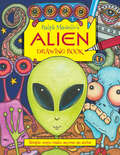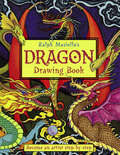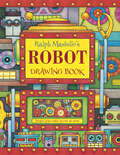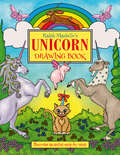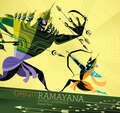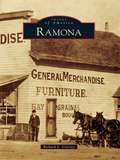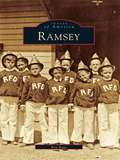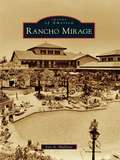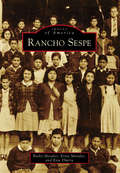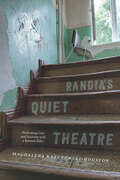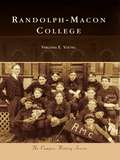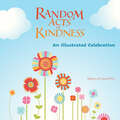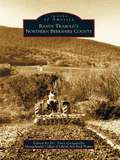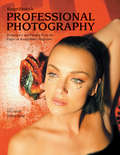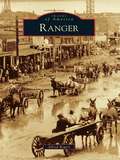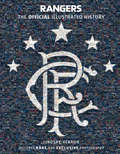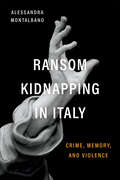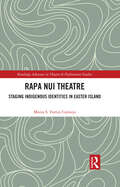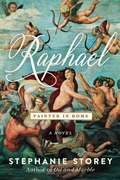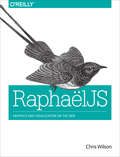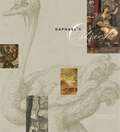- Table View
- List View
Ralph Masiello's Alien Drawing Book (Ralph Masiello's Drawing Books)
by Ralph MasielloThe tenth book in Ralph Masiello’s popular drawing series shows budding artists how to illustrate quirky aliens from out of this world. Clear, linear steps in red outline how to draw the friendly Martians. Challenge steps in blue encourage adding extras to each masterpiece.
Ralph Masiello's Dragon Drawing Book (Ralph Masiello's Drawing Books)
by Ralph MasielloAuthor/illustrator Ralph Masiello explores the world of dragon lore, from the mystical Australian rainbow serpent to the revered imperial dragon of China. Just follow the steps in red to create your own mythical, magical beasts. Extra bonus steps in blue show how to add realistic scales and more advanced details.
Ralph Masiello's Robot Drawing Book (Ralph Masiello's Drawing Books)
by Ralph MasielloThis easy-to-follow guide makes it simple for robot lovers and aspiring artists alike to learn how to draw robots. In step-by-step illustrations, beloved author/illustrator Ralph Masiello shows kids how to use circles, ovals, and other shapes build the body of a basic robot. Then it's off to the warehouse for spare parts where artists can use dials, switches, and antennae to make their design one of a kind. Bonus challenge steps show artists how to add claws, armor, and other fantastic features. The simple shapes and sequenced steps will encourage both confidence and creativity for artists at any level.
Ralph Masiello's Unicorn Drawing Book
by Ralph MasielloStep-by-step diagrams show young artists how to draw fantastic unicorns of all kinds in the newest addition to the popular Ralph Masiello drawing series.By following the simple steps shown in red, mythical creature lovers and aspiring artists can create their own beautiful creatures. With only a few lines, young and young-at-heart artists can draw unikitties, unipiggies, uniowls, and unicorns, as well as hideaways where the most intrepid creature hunters dare to find them.
Ramayana: Divine Loophole
by Sanjay PatelA 21st century retelling of a 2500-year-old story: Artist and veteran Pixar animator Sanjay Patel lends a lush, whimsical illustration style and lighthearted voice to one of Hindu mythology's best-loved and most enduring tales.Teeming with powerful deities, love-struck monsters, flying monkey gods, magic weapons, demon armies, and divine love, Ramayana: Divine Loophole tells the story of Rama, a god-turned-prince, and his quest to rescue his wife Sita after she is kidnapped by a demon king.From princesses in peril to gripping battles, scheming royals, and hordes of bloodthirsty demons, this incredible retelling of the classic Ramayana for kids is the ultimate adventure story presented with an unforgettably modern touch.Fans of Sanjay Patel's books, including The Little Book of Hindu Deities and Ganesha's Sweet Tooth, will be entranced by this ancient story brought to life with more than 100 dazzlingly colorful illustrations. Readers of all ages who love Hindu as well as Celtic, Roman, Chinese, and Greek mythology, and mythological creatures, will enjoy this timeless tale and its essential themes of duty, honor, and loyalty.RAMAYANA ILLUSTRATED FOR A NEW GENERATION: Even readers familiar with this ancient tale will find delight and new understanding in these pages. This keepsake volume includes more than 100 colorful full-spread illustrations, a detailed pictorial glossary of the cast of characters who make up the epic tale, and sketches of the work in progress.GREAT FAMILY READ-ALONG: A hit with parents eager for enthralling books to share with the whole family, Ramayana: Divine Loophole's "incredible illustrations and simple story for kids make this perfect bedtime reading for children aged five and above . . . [A] fun, technicolor way to introduce Hindu mythology to your children." (theswaddle.com)PIXAR ARTIST AUTHOR: Sanjay Patel is a wildly talented artist whose work as an animator and storyboard artist for Pixar Animation Studios includes Monsters, Inc., A Bug's Life, Toy Story 2 and Toy Story 3, Ratatouille, and The Incredibles. His short film Sanjay's Super Team was nominated for an Academy Award for Best Animated Short Film.Perfect for:Readers who love Hindu goddesses, Indian mythology, and ancient adventure talesEducational material for classroom or homeschool curriculumGift giving for Diwali, birthday, graduation, or any special occasionFans of Pixar movies, Classic Tales from India, The Illustrated Mahabharata, and D'Aulaires' Book of Greek Myths
Ramona
by Richard L. CarricoOriginally founded as Nuevo, the community of Ramona is now known affectionately as the Valley of the Sun and was for decades labeled the "Turkey Capital of the World." Long before Spanish missionaries trekked across the verdant valley, 'Ipaay and Kumeyaay Indians called the area home. The temperate climate, fertile valleys, and easy access to both the ocean and to the mountains have made Ramona an ideal place to live for thousands of years. From the Mexican era of land grants to today, Ramona has always been associated with ranching, rodeos, and rural life. Today, nestled in the hills above San Diego, Ramona is a unique blend of rural and urban life.
Ramsey
by Ron KaseIn 1848, farmer Peter Ramsey sold part of his land to the Paterson and Ramapo Railroad for a right-of-way and a station. The Ramsey family had been local landholders since the 1740s, and the railroad timetables called the stop Ramsey's Station. A town developed around the station, and Main Street, which bisected the railroad tracks, became a bustling hub of commerce that supported a growing population. Hotels, general and specialty stores, blacksmithshops, and other businesses offered goods and services to the residents of this center of rural life. Ramsey's Station became the shipping point for strawberries grown throughout the area, making it the nation's strawberry capital until the late 1800s. The fields are gone, but photographs and stories of that era are included in Ramsey, many published here for the first time. Discover Ramsey's past and the pride felt by generations who have called Ramsey their home.
Rancho Mirage
by Leo A. MalletteRancho Mirage is a beautiful residential and desert-resort community nestled along the Santa Rosa Mountains, located between the cities of Palm Springs and Palm Desert in the Coachella Valley. Bighorn sheep and the Agua Caliente tribe of Cahuilla Indians were the area's early inhabitants. Date farms and ranchos developed after aquifers were discovered. Guest ranches soon followed and became favorite destinations for the rich and famous in the 1940s and 1950s. By the early 1950s, residential communities designed in classic Desert Modern style were being constructed along with the valley's first two country clubs with 18-hole golf courses. Rancho Mirage soon emerged as the "golf capital of the world" and has since grown to be a premier resort and residential community with a permanent population of 16,870 and several thousand additional winter residents who enjoy the city's 10 country clubs, three world-class resorts, and scores of restaurants.
Rancho Sespe (Images of America)
by Evie Ybarra Becky Morales Ernie MoralesIn 1833, Rancho Sespe began as a Mexican land grant with 8,881 acres stretching along the Santa Clara River from Piru to Santa Paula. The face of Rancho Sespe is not just the bunkhouse or the family housing that stood on this land; it is, rather, seen in the stories of those who lived and worked on the ranch. Their struggles and triumphs are shared in this book and illustrated with many vintage photographs. The Spaldings developed Rancho Sespe into a very successful ranch for citrus and livestock for over 30 years, and it became a quasi-feudal society as a self-contained working ranch in the 20th century. When the ranch later sold, it ushered in changes for Rancho Sespe to become a part of the modern age, and gone was the worker housing along with other remnants of the past. Many of the families continue to live in the surrounding area generation after generation.
Randia’s Quiet Theatre: Performing Care and Activism with a Romani Elder
by Magdalena Kazubowski-HoustonThroughout Poland, tens of thousands of elderly people live with disabilities in four-storey walk-up apartment buildings. In many cases their children have emigrated; they live with loneliness, a lack of basic amenities, silence, and the absence of care. They are known as “prisoners of the fourth floor.”In Randia’s Quiet Theatre Magdalena Kazubowski-Houston mixes autofiction, ethnography, and theatrical improvisation to unravel the politics of aging in Poland. At the centre of the book is Randia, a Romani fortune teller, storyteller, and performer confined to her fourth-floor apartment in old age. In interviews, Randia’s identity is fixed: she tells of the hardships she faced as a Romani girl and as a wife, mother, and grandmother whose relationship with her family was shaped by separation, sickness, and death. But in storytelling sessions staged in her home, Randia steps into characters and is freed: her tales move between the past, the present, and the future, across life and death; her characters look after one another and change history. Kazubowski-Houston finds in Randia’s performances a quiet activism through which she envisages alternative lives and articulates an ethics of care among individuals, communities, and spirits.Interwoven throughout Randia’s Quiet Theatre are Kazubowski-Houston’s own stories about caring for her elderly and disabled mother, making the book a collaborative, reflexive, and complex creative work. It reveals how ethnographers and their interlocutors can stand on more equal ground. Ultimately it is a profound reflection on how the elderly can live with dignity and how we can care for each other.
Randolph Caldecott: The Man Who Could Not Stop Drawing
by Leonard S. MarcusRandolph Caldecott is best known as the namesake of the award that honors picture book illustrations, and in this inventive biography, leading children's literature scholar Leonard Marcus examines the man behind the medal. In an era when the steam engine fueled an industrial revolution and train travel exploded people's experience of space and time, Caldecott was inspired by his surroundings to capture action, movement, and speed in a way that had never before been seen in children's picture books. Thoroughly researched and featuring extensive archival material and a treasure trove of previously unpublished drawings, including some from Caldecott's very last sketchbook, Leonard Marcus's luminous biography shows why Caldecott was indeed the father of the modern picture book and how his influence lives on in the books we love today.
Randolph County
by L. Mckay WhatleyThe geographic heart of North Carolina, Randolph County has been at the crossroads of history since the 17th century, when explorers first arrived along the Great Indian Trading Path. Every variety of religion, creed, and color could be found in the county from its creation in 1779, with combinations that often proved volatile. From the Uwharrie Mountains in the west to the Deep River Valley on the east, Randolph County has been home to powerful opposing forces. It is a county where potters are more common than doctors. It is home to five of North Carolina's first textile mills, yet it remains one of the state's leading agricultural producers. Its residents refused to secede from the Union but sent six companies into Confederate service. Although settled by pacifist Quakers, bitter guerrilla warfare pitted neighbor against neighbor in both the American Revolution and the Civil War. A dry county that permits no sales of alcoholic beverages, it fostered the racing spirit of NASCA R by running moonshine along its back roads. It is a county with a history, politics, and people of vision, depth, and complexity.
Randolph-Macon College
by Virginia E. YoungRandolph-Macon College was founded as a Methodist-related college in 1830 near Boydton in Mecklenburg County, Virginia. After the Civil War, the college moved along the Richmond, Fredericksburg, and Potomac Railroad tracks to the wooden buildings of a bankrupt resort hotel north of Richmond in Ashland, Virginia. The college was soon known for such innovations as required physical education. Pres. W. W. Smith expanded Randolph-Macon into a system of five institutions, including the women's college in Lynchburg, Virginia. Pres. Robert Emory Blackwell instilled the college philosophy of "hand cultivation" of students, which is still followed today. After World War II, Pres. J. Earl Moreland began building the modern campus. In 1966, African American students were admitted, and though town girls took classes as early as 1893, the college became fully coeducational in 1971. Today the college has grown to over 1,200 students and although still grounded in the liberal arts, majors range from accounting to women's studies.
Random Acts of Kindness: An Illustrated Celebration
by Editors of Conari PressBest of the Inspirational Stories That Triggered a Kindness MovementTrue stories, thoughtful quotations and suggestions to inspire readers to live more compassionately.Experience a book-inspired phenomenon. The unprecedented success of Random Acts of Kindness not only inspired many individuals to be kinder, but also led Congress to declare a National Random Acts of Kindness Week in February 1995. The inspiration for the kindness movement, the book Random Acts of Kindness, is an antidote for a weary world. Its true stories, thoughtful quotations, and suggestions for generosity should inspire you to live more compassionately and be a kinder person.Own the special gift edition. This collection of the "best of the Random Acts” series includes stories of men, women, and children who've reached out to perform acts of kindness that brighten days, improve lives, and sometimes even save others. What if all of a sudden everyone started performing good deeds every day? This inspiring collection presents many true stories of people who've committed, received, and observed voluntary acts of kindness. Hearing their stories reveals how these simple, small acts of goodness can have a profoundly positive effect in the world. This beautiful new edition also includes hundreds of new ideas that readers can use to perform their own random acts and celebrate kindness.Readers of motivational books and stories like Chicken Soup for the Soul: Random Acts of Kindness, A Pebble for Your Thoughts, I've Been Thinking…, and You Can Do All Things will love the encouraging, inspirational stories in Random Acts of Kindness: An Illustrated Celebration.
Randy Trabold's Northern Berkshire County
by Massachusetts College of Liberal Arts Book Project Dr Tony GengarellyRandy Trabold was the chief photographer for the North Adams Transcript from 1935 until he retired in 1979. Randy Trabold's Northern Berkshire County documents his formidable capacity to record the pulse of the northern Berkshire area-from tragedy to laughter and from the bizarre to the incredibly beautiful. While the book features familiar landmarks, such as North Adams, Williamstown, the Mohawk Trail, and Mount Greylock, it also takes a tour of the region's beautiful landscape, revisits the Fall Foliage Festival, and explores the frustrations and humor of Berkshire winters.
Rangefinder's Professional Photography: Techniques and Images from the Pages of Rangefinder Magazine
by Bill HurterThe best images by the best photographers from around the world are featured in this collection that reflects the pinnacle of contemporary photography, both in terms of technical skill and creative ingenuity Appealing to photographers of all levels, this book includes images from all genres of photography#151;from wedding and fashion to portrait and product#151;as well as more than 100 instructive articles. In each chapter, the images and techniques are thematically grouped to provide for rapid learning and easy cross-referencing. The breadth of topics, the high quality of the images, the technical skills required to create them, and the sheer creativity reflected in each shot, makes this collection an essential addition to any photographer's library.
Ranger (Images of America)
by Alfred RogersRanger began in the 1870s near a Texas Ranger camp in northeastern Eastland County. It remained a farming community of about 700 people until October 17, 1917, when an oil well on the McCleskey farm, south of town, ushered in one of the best-known oil discoveries. Within months, Ranger's population had surged to approximately 30,000, including investors, speculators, wildcatters, oil field workers, curious onlookers, and the usual criminal element attracted to oil boomtowns. Crime became so rampant that the Texas Rangers eventually were called in to intercede. Oil production peaked in 1919 before tapering off. Images of America: Ranger covers a period of about 75 years from the town's beginnings to 1950.
Rangers: A Visual Celebration of 140 Glorious Years
by Rangers Fc Lindsay HerronPeppered throughout with more than 200 images from Ibrox's official archives - many of them never before published - this sumptious publication captures the club's rich heritage and proud pedigree of great managers and players, devoted fans, and an almost endless list of trophies. Rangers FC has experienced the highs and lows of everything that the sport can throw at it, yet the passion and faith of its enormous fan base continues to endure as the club enters a brave new era. This evocative new publication seeks to pay testament to the Ibrox spirit and everything it stands for.
Ransom Kidnapping in Italy: Crime, Memory, and Violence (Toronto Italian Studies)
by Alessandra MontalbanoFor over thirty years, modern Italy was plagued by ransom kidnappings perpetrated by bandits and organized crime syndicates. Nearly 700 men, women, and children were abducted from across the country between the late 1960s and the late 1990s, held hostage by members of the Sardinian banditry, Cosa Nostra, and the ’Ndrangheta. Subjected to harsh captivities and psychological abuse, the victims spent months and even years in isolation while law enforcement and the state struggled to find them. Ransom Kidnapping in Italy examines this Italian criminal phenomenon. Alessandra Montalbano argues that abduction is a key vantage point from which to understand modern Italy: it troubled the law, terrified society, ignited juridical and parliamentary debates, and mobilized citizens. Bringing together archival and media materials with the victims’ accounts and diverse forms of cultural response, the book examines ransom kidnapping through the lenses of historiography, law, literary criticism, trauma studies, phenomenology, and political philosophy. Ransom Kidnapping in Italy traces how and at what price Italians became aware of living in a country that was being blackmailed by criminal organizations that arguably jeoparded the nation even more than terrorism.
Ransomware Analysis: Knowledge Extraction and Classification for Advanced Cyber Threat Intelligence
by Jérôme François Claudia Lanza Abdelkader LahmadiThis book presents the development of a classification scheme to organize and represent ransomware threat knowledge through the implementation of an innovative methodology centered around the semantic annotation of domain-specific source documentation. By combining principles from computer science, document management, and semantic data processing, the research establishes an innovative framework to organize ransomware data extracted from specialized source texts in a systematic classification system.Through detailed chapters, the book explores the process of applying semantic annotation to a specialized corpus comprising CVE prose descriptions linked to known ransomware threats. This approach not only organizes but also deeply analyzes these descriptions, uncovering patterns and vulnerabilities within ransomware operations. The book presents a pioneering methodology that integrates CVE descriptions with ATT&CK frameworks, significantly refining the granularity of threat intelligence.The insights gained from a pattern-based analysis of vulnerability-related documentation are structured into a hierarchical model within an ontology framework, enhancing the capability for predictive operations. This model prepares cybersecurity professionals to anticipate and mitigate risks associated with new vulnerabilities as they are cataloged in the CVE list, by identifying recurrent characteristics tied to specific ransomware and related vulnerabilities.With real-world examples, this book empowers its readers to implement these methodologies in their environments, leading to improved prediction and prevention strategies in the face of growing ransomware challenges.
Rapa Nui Theatre: Staging Indigenous Identities in Easter Island (Routledge Advances in Theatre & Performance Studies #1)
by Moira Fortin CornejoThis book examines the relationships between theatrical representations and socio-political aspects of Rapa Nui culture from pre-colonial times to the present. This is the first book written about the production of Rapa Nui theatre, which is understood as a unique and culturally distinct performance tradition. Using a multilingual approach, this book journeys through Oceania, reclaiming a sense of connection and reflecting on synergies between performances of Oceanic cultures beyond imagined national boundaries. The author argues for a holistic and inclusive understanding of Rapa Nui theatre as encompassing and being inspired by diverse aspects of Rapa Nui performance cultures, festivals, and art forms. This book will be of great interest to students and scholars of Indigenous studies, Pacific Island studies, performance, anthropology, theatre education and Rapa Nui community, especially schoolchildren from the island who are learning about their own heritage.
Raphael (Getting to Know the World's Greatest Artists)
by Mike VeneziaBriefly introduces Raphael, a well-known Italian painter, who modeled several styles and techniques and made them his own.
Raphael, Painter in Rome: A Novel
by Stephanie StoreyAnother Fabulous Art History Thriller by the Bestselling Author of Oil and Marble, Featuring the Master of Renaissance Perfection: Raphael! Michelangelo&’s Sistine Chapel ceiling is one of the most iconic masterpieces of the Renaissance. Here, in Raphael, Painter in Rome, Storey tells of its creation as never before: through the eyes of Michelangelo&’s fiercest rival—the young, beautiful, brilliant painter of perfection, Raphael. Orphaned at age eleven, Raphael is determined to keep the deathbed promise he made to his father: become the greatest artist in history. But to be the best, he must beat the best, the legendary sculptor of the David, Michelangelo Buonarroti. When Pope Julius II calls both artists down to Rome, they are pitted against each other: Michelangelo painting the Sistine Ceiling, while Raphael decorates the pope's private apartments. As Raphael strives toward perfection in paint, he battles internal demons: his desperate ambition, crippling fear of imperfection, and unshakable loneliness. Along the way, he conspires with cardinals, scrambles through the ruins of ancient Rome, and falls in love with a baker&’s-daughter-turned-prostitute who becomes his muse. With its gorgeous writing, rich settings, endearing characters, and riveting plot, Raphael, Painter in Rome brings to vivid life these two Renaissance masters going head to head in the deadly halls of the Vatican.
RaphaelJS: Graphics and Visualization on the Web
by Chris WilsonCreate beautiful, interactive images on the Web with RaphaëlJS, the JavaScript library that lets you draw Scalable Vector Graphics (SVG) right in the browser. With this concise guide, you’ll quickly learn how to paint the screen with shapes and colors that you can turn into lively, animated graphics and visualizations.Author Chris Wilson (Time.com) shows you how to create Raphaël objects and manipulate them with animation, transformations, and other techniques, using just a few lines of code. Packed with working examples, sample code, and cool hands-on projects, RaphaëlJS is ideal for new and experienced JavaScript programmers alike.Create images that work on browsers new and old, as well as mobile devicesStart with the basics—shapes, colors, transformations, sets, and textLearn how to build custom curves and shapes with pathsCode animations that move through space, follow paths, or change directionMake your artwork come alive through user interactionBind a dataset to a collection of visual objects—the basis of data visualizationLearn techniques to make your detailed visuals stand out on screens of any size
Raphael’s Ostrich
by Una Roman D’EliaRaphael’s Ostrich begins with a little-studied aspect of Raphael’s painting—the ostrich, which appears as an attribute of Justice, painted in the Sala di Costantino in the Vatican. Una Roman D’Elia traces the cultural and artistic history of the ostrich from its appearances in ancient Egyptian hieroglyphs to the menageries and grotesque ornaments of sixteenth-century Italy. Following the complex history of shifting interpretations given to the ostrich in scientific, literary, religious, poetic, and satirical texts and images, D’Elia demonstrates the rich variety of ways in which people made sense of this living “monster,” which was depicted as the embodiment of heresy, stupidity, perseverance, justice, fortune, gluttony, and other virtues and vices. Because Raphael was revered as a god of art, artists imitated and competed with his ostrich, while religious and cultural critics complained about the potential for misinterpreting such obscure imagery. This book not only considers the history of the ostrich but also explores how Raphael’s painting forced viewers to question how meaning is attributed to the natural world, a debate of central importance in early modern Europe at a time when the disciplines of modern art history and natural history were developing. The strangeness of Raphael’s ostrich, situated at the crossroads of art, religion, myth, and natural history, both reveals lesser-known sides of Raphael’s painting and illuminates major cultural shifts in attitudes toward nature and images in the Renaissance. More than simply an examination of a single artist or a single subject, Raphael’s Ostrich offers an accessible, erudite, and charming alternative to Vasari’s pervasive model of the history of sixteenth-century Italian art.
